Abstract
A randomized comparison trial of two very low calorie weight reduction diets was carried out for 5 or 8 wk in 17 healthy obese women. One diet provided 1.5 g protein/kg ideal body weight; the other provided 0.8 g protein/kg ideal body weight plus 0.7 g carbohydrate/kg ideal body weight. The diets were isocaloric (500 kcal). Amino acid metabolism was studied by means of tracer infusions of L-[1-13C]leucine and L-[15N]alanine. After 3 wk of adaptation to the diets, nitrogen balance was zero for the 1.5 g protein diet but -2 g N/d for the 0.8 g protein diet. Postabsorptive plasma leucine and alanine flux decreased from base line by an equal extent with both diets by approximately 20 and 40%, respectively. It was concluded that protein intakes at the level of the recommended dietary allowance (0.8 g/kg) are not compatible with nitrogen equilibrium when the energy intake is severely restricted, and that nitrogen balance is improved by increasing the protein intake above that level. Basal rates of whole body nitrogen turnover are relatively well maintained, compared with total fasting, at both protein intakes. However, turnover in the peripheral compartment, as evidenced by alanine flux, may be markedly diminished with either diet.
Full text
PDF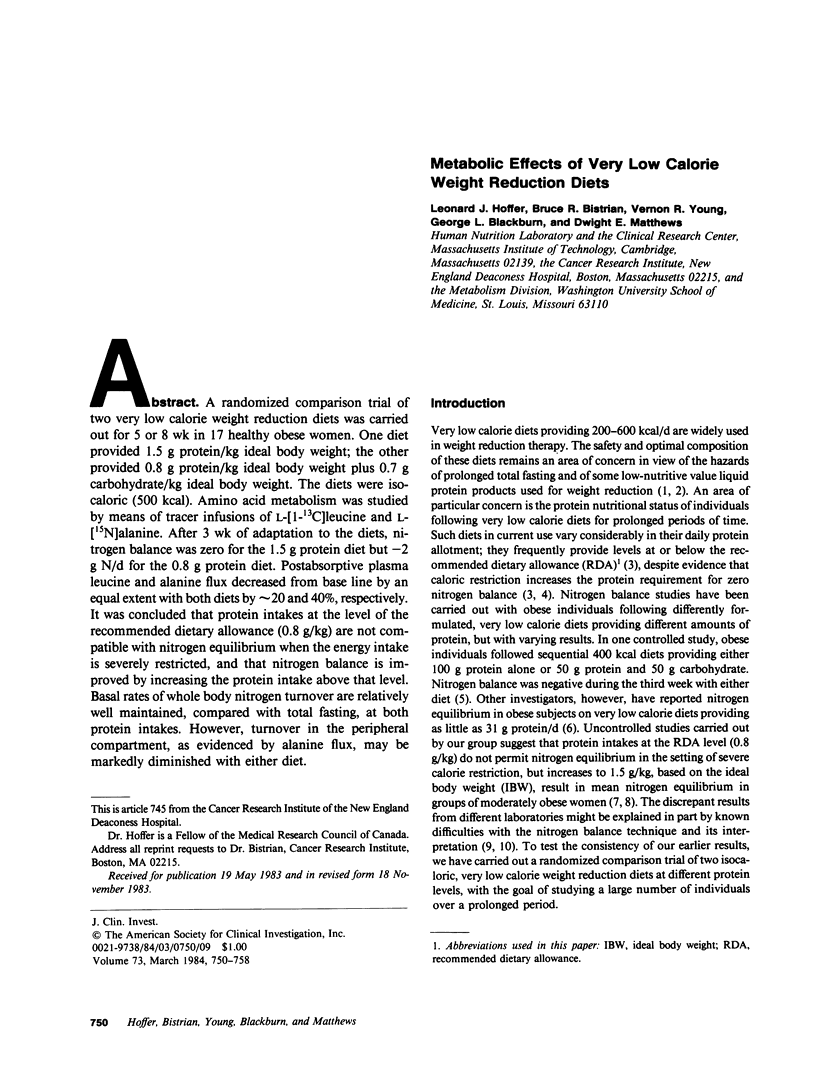
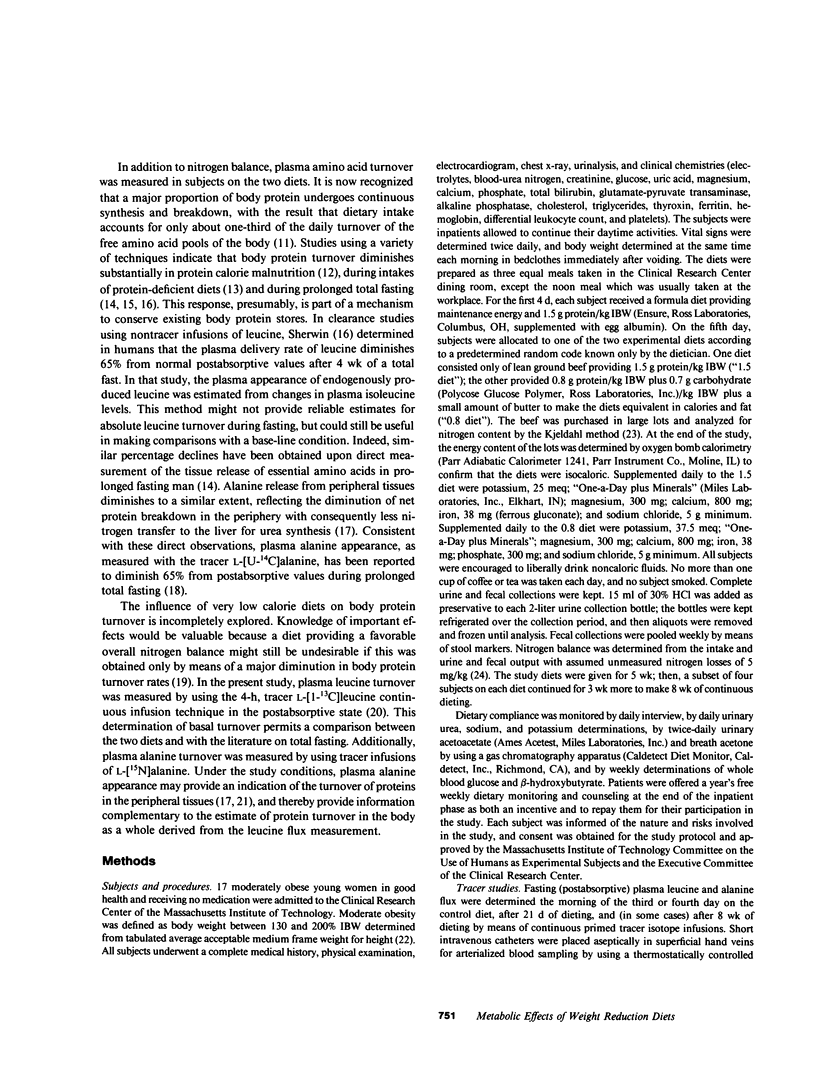
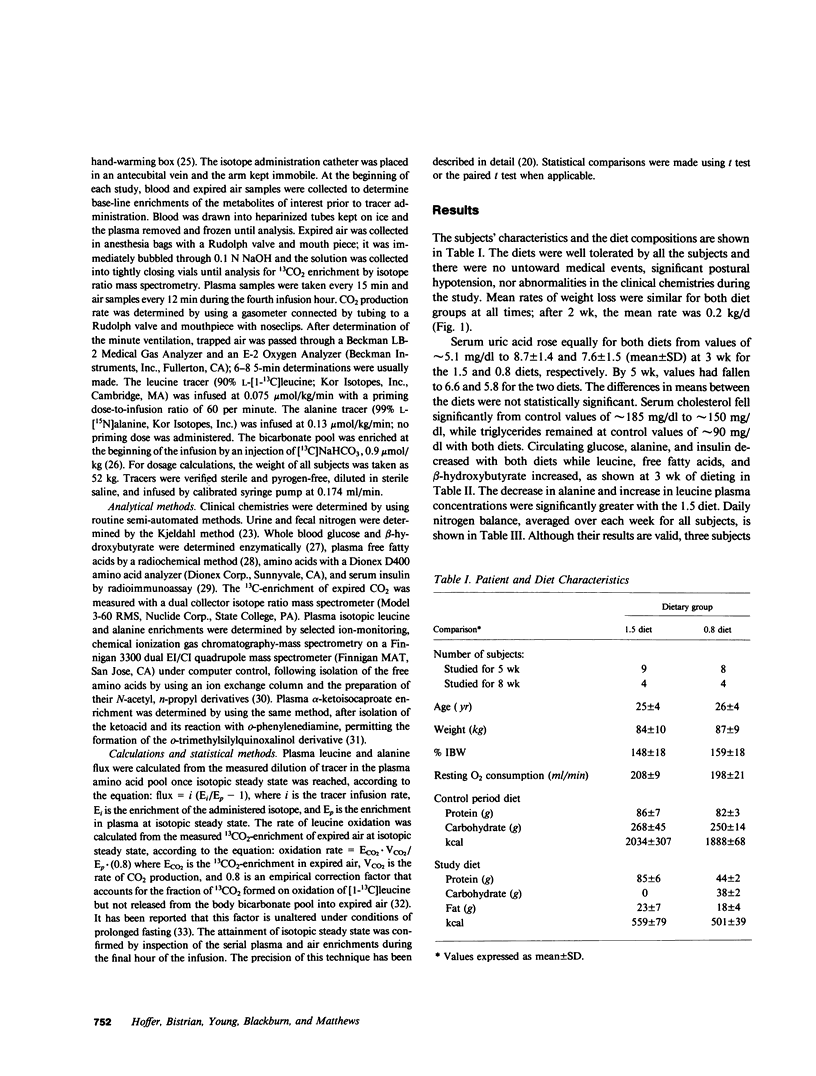
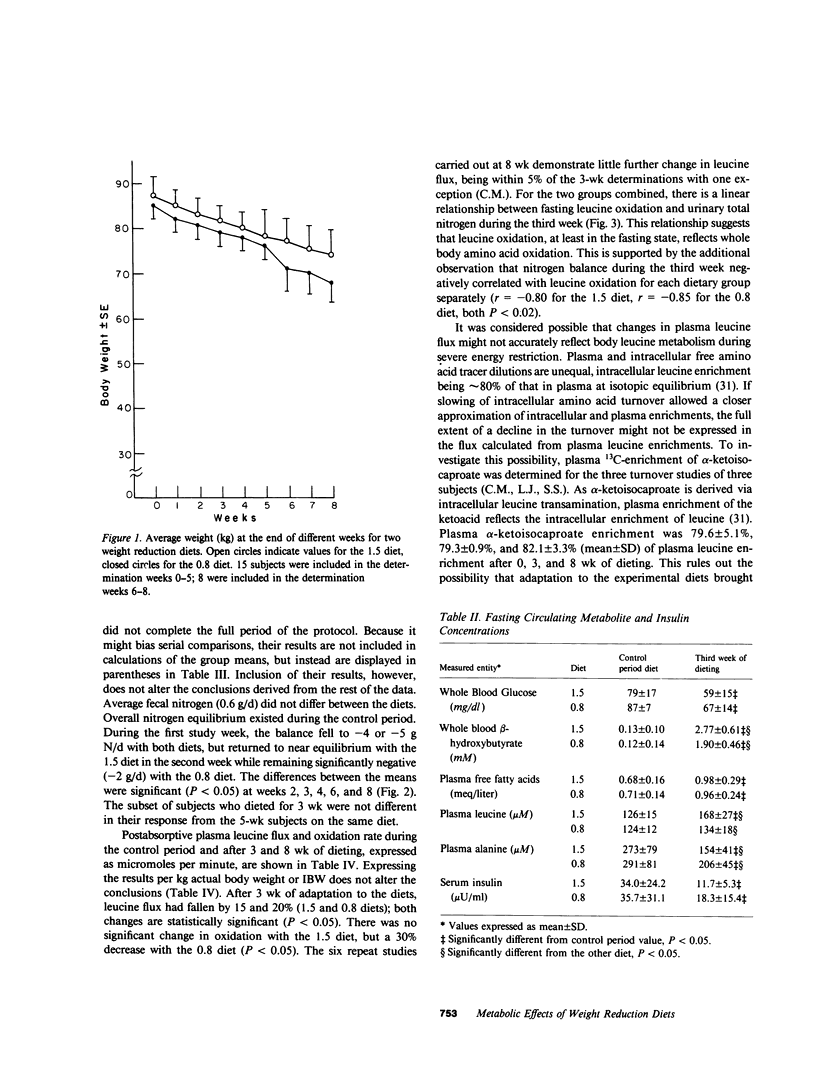
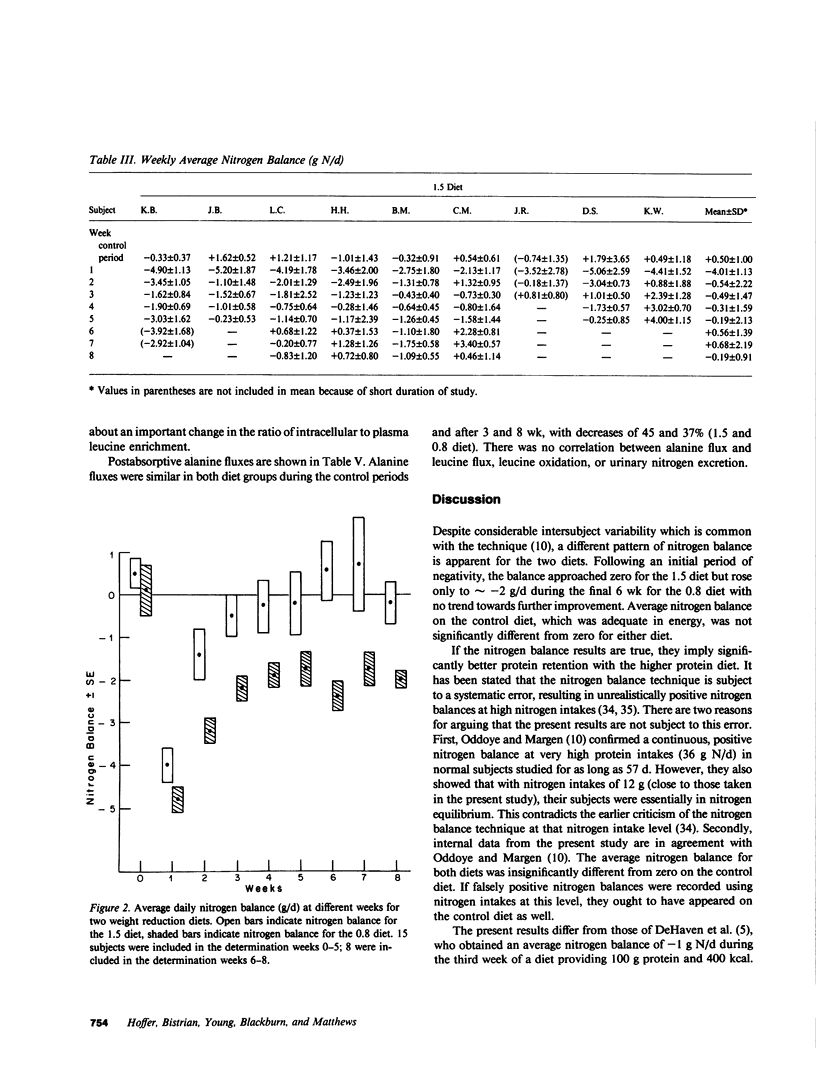
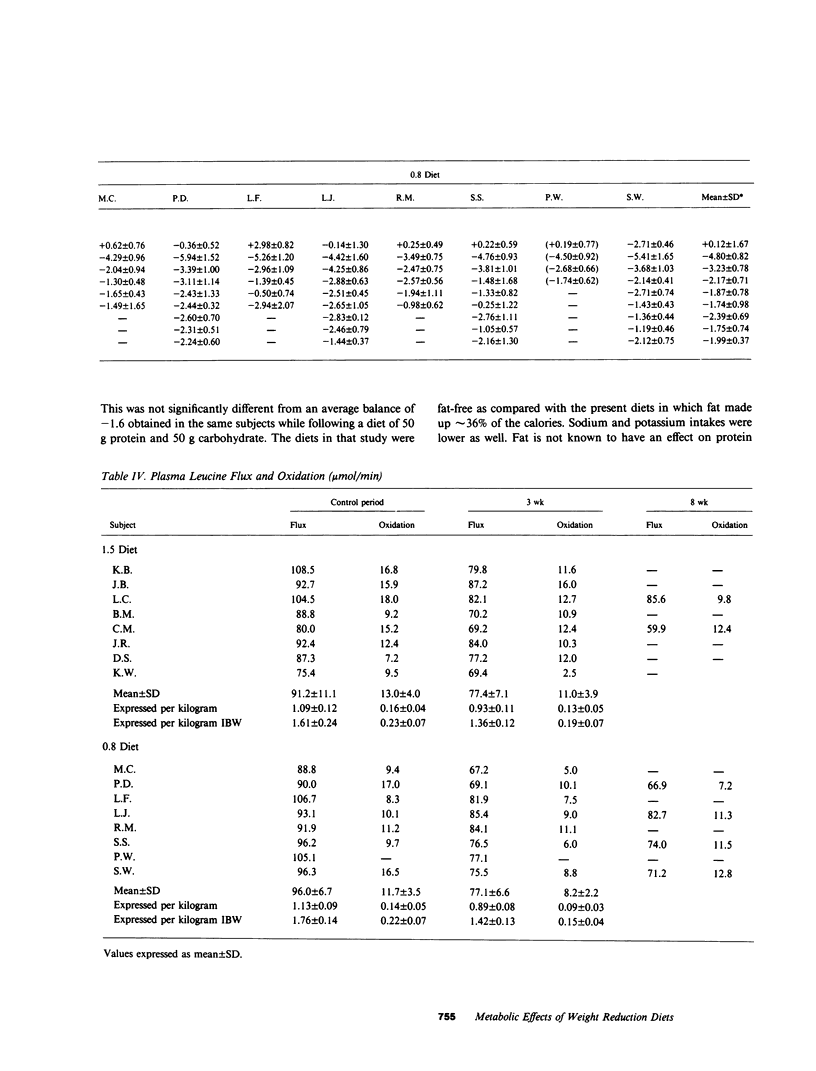
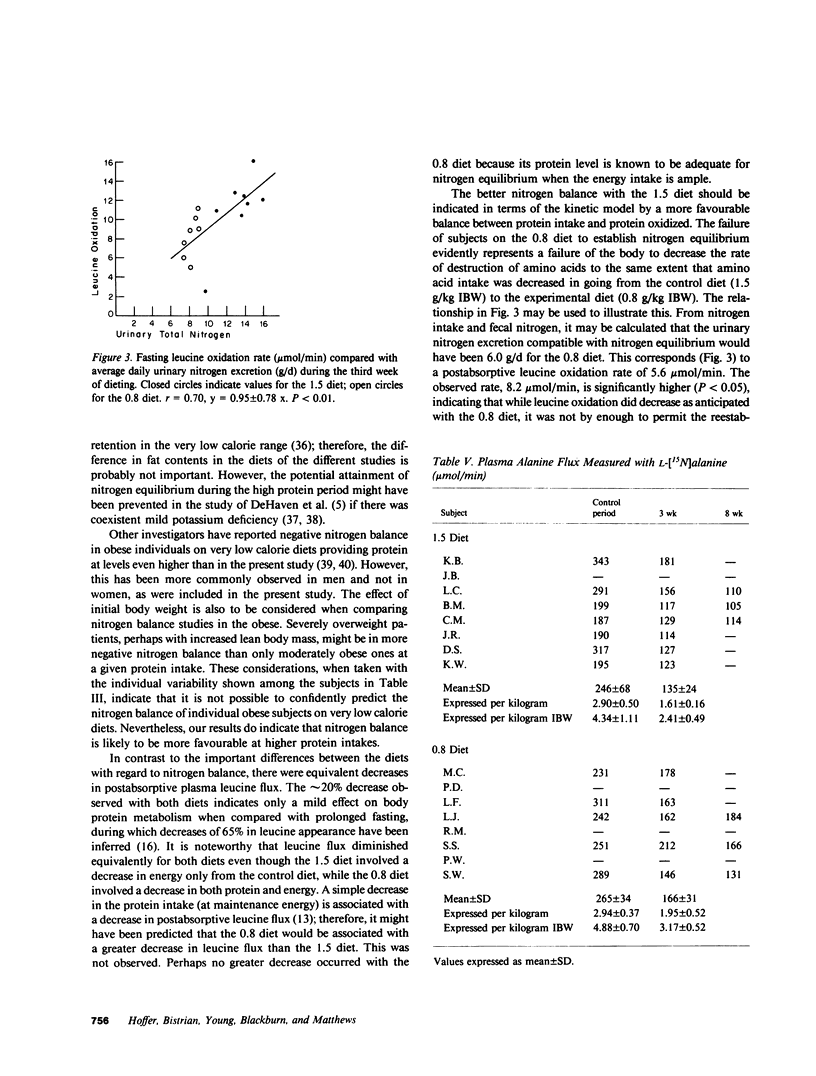
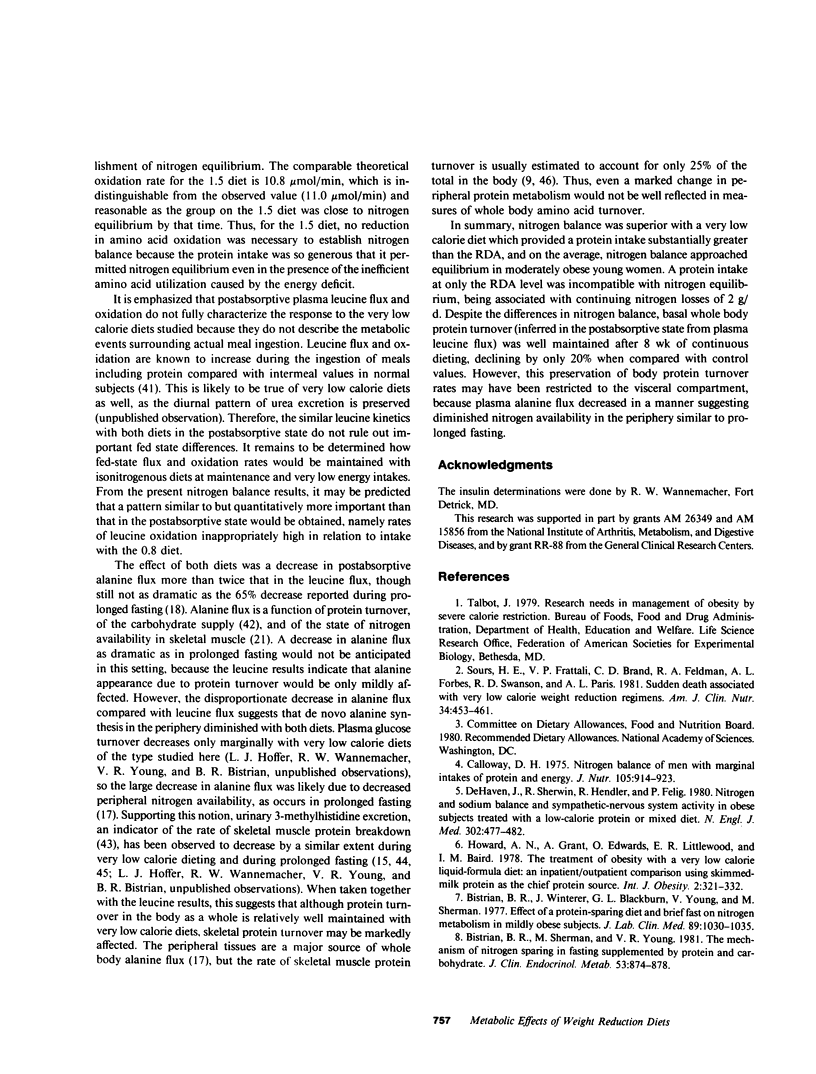
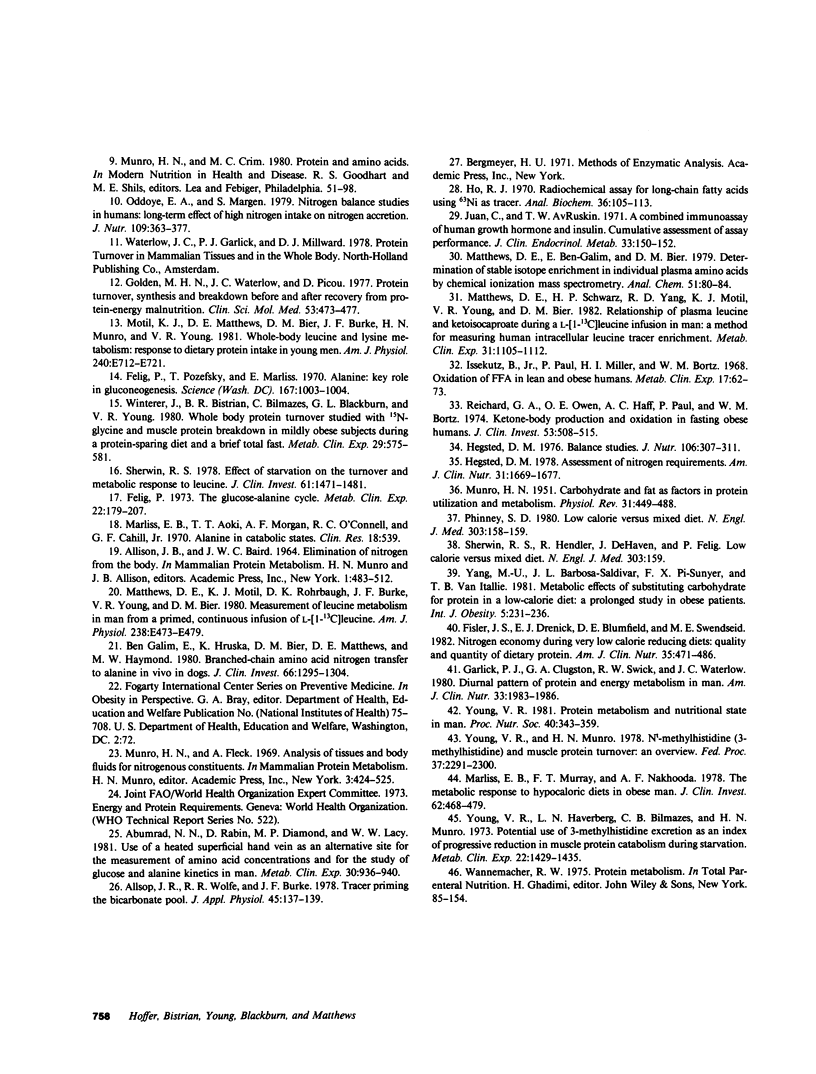
Selected References
These references are in PubMed. This may not be the complete list of references from this article.
- Abumrad N. N., Rabin D., Diamond M. P., Lacy W. W. Use of a heated superficial hand vein as an alternative site for the measurement of amino acid concentrations and for the study of glucose and alanine kinetics in man. Metabolism. 1981 Sep;30(9):936–940. doi: 10.1016/0026-0495(81)90074-3. [DOI] [PubMed] [Google Scholar]
- Allsop J. R., Wolfe R. R., Burke J. F. Tracer priming the bicarbonate pool. J Appl Physiol Respir Environ Exerc Physiol. 1978 Jul;45(1):137–139. doi: 10.1152/jappl.1978.45.1.137. [DOI] [PubMed] [Google Scholar]
- Bistrian B. R., Sherman M., Young V. The mechanisms of nitrogen sparing in fasting supplemented by protein and carbohydrate. J Clin Endocrinol Metab. 1981 Oct;53(4):874–878. doi: 10.1210/jcem-53-4-874. [DOI] [PubMed] [Google Scholar]
- Bistrian D. R., Winterer J., Blackburn G. L., Young V., Sherman M. Effect of a protein-sparing diet and brief fast on nitrogen metabolism in mildly obese subjects. J Lab Clin Med. 1977 May;89(5):1030–1035. [PubMed] [Google Scholar]
- Calloway D. H. Nitrogen balance of men with marginal intakes of protein and energy. J Nutr. 1975 Jul;105(7):914–923. doi: 10.1093/jn/105.7.914. [DOI] [PubMed] [Google Scholar]
- DeHaven J., Sherwin R., Hendler R., Felig P. Nitrogen and sodium balance and sympathetic-nervous-system activity in obese subjects treated with a low-calorie protein or mixed diet. N Engl J Med. 1980 Feb 28;302(9):477–482. doi: 10.1056/NEJM198002283020901. [DOI] [PubMed] [Google Scholar]
- Felig P., Pozefsky T., Marliss E., Cahill G. F., Jr Alanine: key role in gluconeogenesis. Science. 1970 Feb 13;167(3920):1003–1004. doi: 10.1126/science.167.3920.1003. [DOI] [PubMed] [Google Scholar]
- Felig P. The glucose-alanine cycle. Metabolism. 1973 Feb;22(2):179–207. doi: 10.1016/0026-0495(73)90269-2. [DOI] [PubMed] [Google Scholar]
- Fisler J. S., Drenick E. J., Blumfield D. E., Swendseid M. E. Nitrogen economy during very low calorie reducing diets: quality and quantity of dietary protein. Am J Clin Nutr. 1982 Mar;35(3):471–486. doi: 10.1093/ajcn/35.3.471. [DOI] [PubMed] [Google Scholar]
- Galim E. B., Hruska K., Bier D. M., Matthews D. E., Haymond M. W. Branched-chain amino acid nitrogen transfer to alamine in vivo in dogs. Direct isotopic determination with [15N]leucine. J Clin Invest. 1980 Dec;66(6):1295–1304. doi: 10.1172/JCI109981. [DOI] [PMC free article] [PubMed] [Google Scholar]
- Garlick P. J., Clugston G. A., Swick R. W., Waterlow J. C. Diurnal pattern of protein and energy metabolism in man. Am J Clin Nutr. 1980 Sep;33(9):1983–1986. doi: 10.1093/ajcn/33.9.1983. [DOI] [PubMed] [Google Scholar]
- Golden M. H., Waterlow J. C., Picou D. Protein turnover, synthesis and breakdown before and after recovery from protein-energy malnutrition. Clin Sci Mol Med. 1977 Nov;53(5):473–477. doi: 10.1042/cs0530473. [DOI] [PubMed] [Google Scholar]
- Hegsted D. M. Assessment of nitrogen requirements. Am J Clin Nutr. 1978 Sep;31(9):1669–1677. doi: 10.1093/ajcn/31.9.1669. [DOI] [PubMed] [Google Scholar]
- Ho R. J. Radiochemical assay of long-chain fatty acids using 63Ni as tracer. Anal Biochem. 1970 Jul;36(1):105–113. doi: 10.1016/0003-2697(70)90337-4. [DOI] [PubMed] [Google Scholar]
- Howard A. N., Grant A., Edwards O., Littlewood E. R., McLean Baird I. The treatment of obesity with a very-low-calorie liquid-formula diet: an inpatient/outpatient comparison using skimmed-milk protein as the chief protein source. Int J Obes. 1978;2(3):321–332. [PubMed] [Google Scholar]
- Issekutz B., Jr, Paul P., Miller H. I., Bortz W. M. Oxidation of plasma FFA in lean and obese humans. Metabolism. 1968 Jan;17(1):62–73. doi: 10.1016/s0026-0495(68)80008-3. [DOI] [PubMed] [Google Scholar]
- Juan C., AvRuskin T. W. A combined immunoassay of human growth hormone and insulin: cumulative assessment of assay performance. J Clin Endocrinol Metab. 1971 Jul;33(1):150–152. doi: 10.1210/jcem-33-1-150. [DOI] [PubMed] [Google Scholar]
- MUNRO H. N. Carbohydrate and fat as factors in protein utilization and metabolism. Physiol Rev. 1951 Oct;31(4):449–488. doi: 10.1152/physrev.1951.31.4.449. [DOI] [PubMed] [Google Scholar]
- Marliss E. B., Murray F. T., Nakhooda A. F. The metabolic response to hypocaloric protein diets in obese man. J Clin Invest. 1978 Aug;62(2):468–479. doi: 10.1172/JCI109148. [DOI] [PMC free article] [PubMed] [Google Scholar]
- Matthews D. E., Ben-Galim E., Bier D. M. Determination of stable isotopic enrichment in individual plasma amino acids by chemical ionization mass spectrometry. Anal Chem. 1979 Jan;51(1):80–84. doi: 10.1021/ac50037a028. [DOI] [PubMed] [Google Scholar]
- Matthews D. E., Motil K. J., Rohrbaugh D. K., Burke J. F., Young V. R., Bier D. M. Measurement of leucine metabolism in man from a primed, continuous infusion of L-[1-3C]leucine. Am J Physiol. 1980 May;238(5):E473–E479. doi: 10.1152/ajpendo.1980.238.5.E473. [DOI] [PubMed] [Google Scholar]
- Matthews D. E., Schwarz H. P., Yang R. D., Motil K. J., Young V. R., Bier D. M. Relationship of plasma leucine and alpha-ketoisocaproate during a L-[1-13C]leucine infusion in man: a method for measuring human intracellular leucine tracer enrichment. Metabolism. 1982 Nov;31(11):1105–1112. doi: 10.1016/0026-0495(82)90160-3. [DOI] [PubMed] [Google Scholar]
- Motil K. J., Matthews D. E., Bier D. M., Burke J. F., Munro H. N., Young V. R. Whole-body leucine and lysine metabolism: response to dietary protein intake in young men. Am J Physiol. 1981 Jun;240(6):E712–E721. doi: 10.1152/ajpendo.1981.240.6.E712. [DOI] [PubMed] [Google Scholar]
- Oddoye E. A., Margen S. Nitrogen balance studies in humans: long-term effect of high nitrogen intake on nitrogen accretion. J Nutr. 1979 Mar;109(3):363–377. doi: 10.1093/jn/109.3.363. [DOI] [PubMed] [Google Scholar]
- Phinney S. D. Low-calorie protein versus mixed diet. N Engl J Med. 1980 Jul 17;303(3):158–158. [PubMed] [Google Scholar]
- Reichard G. A., Jr, Owen O. E., Haff A. C., Paul P., Bortz W. M. Ketone-body production and oxidation in fasting obese humans. J Clin Invest. 1974 Feb;53(2):508–515. doi: 10.1172/JCI107584. [DOI] [PMC free article] [PubMed] [Google Scholar]
- Sherwin R. S. Effect of starvation on the turnover and metabolic response to leucine. J Clin Invest. 1978 Jun;61(6):1471–1481. doi: 10.1172/JCI109067. [DOI] [PMC free article] [PubMed] [Google Scholar]
- Sours H. E., Frattali V. P., Brand C. D., Feldman R. A., Forbes A. L., Swanson R. C., Paris A. L. Sudden death associated with very low calorie weight reduction regimens. Am J Clin Nutr. 1981 Apr;34(4):453–461. doi: 10.1093/ajcn/34.4.453. [DOI] [PubMed] [Google Scholar]
- Winterer J., Bistrian B. R., Bilmazes C., Blackburn G. L., Young V. R. Whole body protein turnover, studied with 15N-glycine, and muscle protein breakdown in mildly obese subjects during a protein-sparing diet and a brief total fast. Metabolism. 1980 Jun;29(6):575–581. doi: 10.1016/0026-0495(80)90085-2. [DOI] [PubMed] [Google Scholar]
- Yang M. U., Barbosa-Saldivar J. L., Pi-Sunyer F. X., Van Itallie T. B. Metabolic effects of substituting carbohydrate for protein in a low-calorie diet: a prolonged study in obese patients. Int J Obes. 1981;5(3):231–236. [PubMed] [Google Scholar]
- Young V. R., Havenberg L. N., Bilmazes C., Munro H. N. Potential use of 3-methylhistidine excretion as an index of progressive reduction in muscle protein catabolism during starvation. Metabolism. 1973 Nov;23(2):1429–1436. doi: 10.1016/0026-0495(73)90257-6. [DOI] [PubMed] [Google Scholar]
- Young V. R., Munro H. N. Ntau-methylhistidine (3-methylhistidine) and muscle protein turnover: an overview. Fed Proc. 1978 Jul;37(9):2291–2300. [PubMed] [Google Scholar]
- Young V. R. Protein metabolism and nutritional state in man. Proc Nutr Soc. 1981 Sep;40(3):343–359. doi: 10.1079/pns19810050. [DOI] [PubMed] [Google Scholar]


